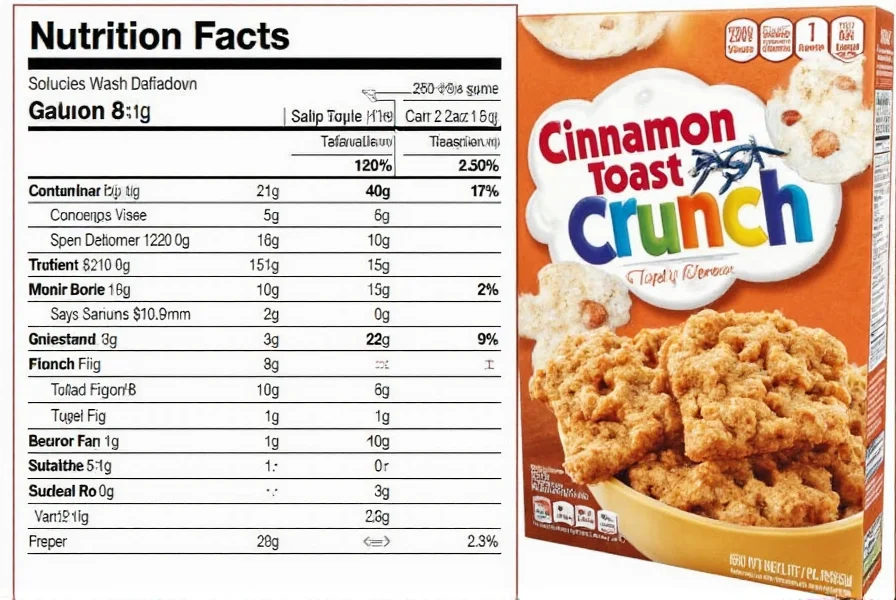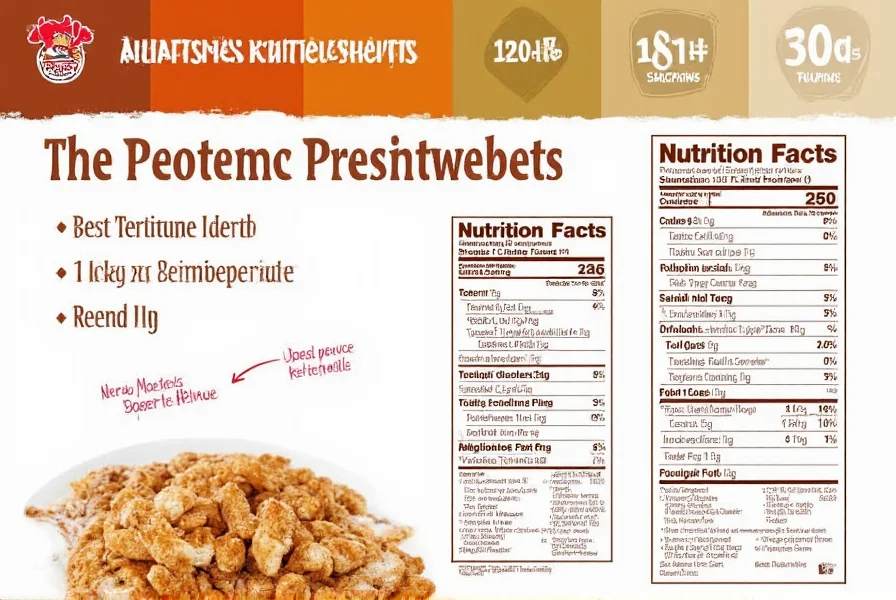One 3/4 cup (30g) serving of Cinnamon Toast Crunch contains 120 calories, 3.5g total fat, 190mg sodium, 23g total carbohydrates, 9g sugar, and 1g protein. The cereal is fortified with essential vitamins and minerals including 50% of the daily value for iron and various B vitamins. While it provides some nutritional benefits through fortification, its relatively high sugar content compared to whole grain cereals should be considered as part of a balanced diet.
Understanding the complete nutritional profile of Cinnamon Toast Crunch helps consumers make informed choices about incorporating this popular breakfast cereal into their dietary patterns. This analysis examines not just the basic nutrition facts but also provides context about how these values fit within daily nutritional recommendations.
Nutrition Facts Breakdown for Cinnamon Toast Crunch
When evaluating cinnamon toast crunch nutrition facts per serving, it's essential to understand that the standard serving size is smaller than many people typically consume. The official nutrition information is based on a 3/4 cup (30g) portion, which contains:
| Nutrient | Amount per Serving | % Daily Value* |
|---|---|---|
| Calories | 120 | |
| Total Fat | 3.5g | 4% |
| Saturated Fat | 0.5g | 3% |
| Trans Fat | 0g | |
| Cholesterol | 0mg | 0% |
| Sodium | 190mg | 8% |
| Total Carbohydrate | 23g | 8% |
| Dietary Fiber | 1g | 4% |
| Total Sugars | 9g | |
| Included Added Sugars | 9g | 18% |
| Protein | 1g | |
| Vitamin D | 0mcg | 0% |
| Calcium | 10mg | 0% |
| Iron | 4.5mg | 25% |
| Potassium | 20mg | 0% |
*Percent Daily Values are based on a 2,000 calorie diet. Your daily values may be higher or lower depending on your calorie needs.
Serving Size Reality Check
One critical aspect of cinnamon toast crunch nutrition facts analysis is recognizing that the standard 3/4 cup serving size often doesn't reflect real-world consumption. Many adults pour 1.5 to 2 cups in a single bowl, effectively doubling or tripling the nutritional values shown on the label. This serving size discrepancy significantly impacts the actual sugar and calorie intake when enjoying this cereal.
Sugar Content: What the Numbers Mean
The how much sugar in cinnamon toast crunch question reveals an important nutritional consideration. With 9g of sugar per 3/4 cup serving (18% of the recommended daily limit for added sugars), this cereal falls on the higher end of the spectrum compared to many whole grain options. For context, the American Heart Association recommends no more than 25g of added sugar per day for women and 36g for men.
When examining the cinnamon toast crunch ingredients list, sugar appears as the third ingredient after whole grain rice and corn flour, followed by cinnamon. The specific sugar sources include sugar, brown sugar, and high fructose corn syrup in some formulations.
Protein and Fiber Evaluation
With only 1g of protein and 1g of dietary fiber per serving, Cinnamon Toast Crunch provides minimal amounts of these important nutrients. The cinnamon toast crunch protein content is notably low compared to higher-protein cereal alternatives like Kashi or Ezekiel brands, which often contain 5-10g of protein per serving.
Likewise, the cinnamon toast crunch fiber content represents just 4% of the daily recommended intake. Most nutritionists recommend cereals with at least 3g of fiber per serving to support digestive health and provide more sustained energy release.
Vitamin and Mineral Fortification
Where Cinnamon Toast Crunch shows nutritional strength is in its fortification profile. The cereal provides significant amounts of several B vitamins and iron:
- Vitamin B3 (Niacin): 20% DV
- Vitamin B6: 20% DV
- Vitamin B2 (Riboflavin): 20% DV
- Vitamin B1 (Thiamin): 20% DV
- Folic Acid: 25% DV
- Iron: 25% DV
This fortification makes Cinnamon Toast Crunch a source of essential micronutrients, though it doesn't compensate for the relatively low fiber and protein content.
Ingredient Analysis
The complete cinnamon toast crunch ingredients list typically includes: whole grain rice, sugar, corn flour, canola and/or sunflower oil, salt, cinnamon, brown sugar syrup, natural and artificial flavor, BHT for freshness, and various vitamins and minerals. The "Crunch" pieces that give the cereal its distinctive texture contain additional sugar, corn syrup, and dextrose.
Notably absent are significant sources of whole grains beyond the rice base, and the cereal contains no fruit, nuts, or seeds that might enhance its nutritional profile.
Dietary Considerations
When evaluating is cinnamon toast crunch healthy as part of your diet, consider these factors:
- It can fit into a balanced diet when consumed in appropriate portions
- Pairing it with milk (dairy or fortified plant-based) adds protein and calcium
- Adding fresh fruit like berries increases fiber and nutrient density
- It's not ideal as a daily breakfast choice for those monitoring sugar intake
- May be appropriate as an occasional treat or for active individuals with higher calorie needs
Comparison to Similar Cereals
Understanding cinnamon toast crunch vs other cereals nutrition provides helpful context:
- Compared to Frosted Flakes: Similar sugar content but Cinnamon Toast Crunch has slightly more fiber
- Compared to plain Cheerios: Significantly higher in sugar but provides more fortification
- Compared to Kashi Indigo Morning: Much lower in protein and fiber than this whole grain alternative
- Compared to Special K: Similar calorie count but Special K has slightly less sugar and more protein

Practical Consumption Tips
To make the most of Cinnamon Toast Crunch while managing its nutritional limitations:
- Measure your serving using an actual measuring cup rather than pouring freely
- Mix with a higher-fiber cereal to boost nutritional value
- Add a protein source like nuts, seeds, or Greek yogurt on the side
- Choose lower-sugar milk alternatives to balance overall sugar content
- Consider it as an occasional treat rather than a daily breakfast staple
Final Assessment
Cinnamon Toast Crunch offers a tasty breakfast option with notable vitamin fortification, but its relatively high sugar content and low fiber and protein levels mean it shouldn't be considered a nutritionally complete breakfast choice. When consumed in proper portions as part of an otherwise balanced diet, it can fit into many eating patterns, particularly for active individuals or as an occasional treat. Understanding the complete cinnamon toast crunch nutrition facts breakdown empowers consumers to make informed decisions about incorporating this popular cereal into their dietary routine.
Frequently Asked Questions
How many calories are in a serving of Cinnamon Toast Crunch?
One standard serving of Cinnamon Toast Crunch (3/4 cup or 30g) contains 120 calories. However, many people consume larger portions, which would increase the calorie count proportionally.
What is the sugar content in Cinnamon Toast Crunch?
Cinnamon Toast Crunch contains 9g of sugar per 3/4 cup serving, which represents 18% of the recommended daily limit for added sugars. Sugar is the third ingredient in the cereal, following whole grain rice and corn flour.
Does Cinnamon Toast Crunch have any nutritional benefits?
Yes, Cinnamon Toast Crunch is fortified with several important nutrients including 25% of the daily value for iron and 20% for various B vitamins (niacin, B6, riboflavin, and thiamin). However, it's relatively low in fiber (1g per serving) and protein (1g per serving) compared to whole grain cereal alternatives.
How does Cinnamon Toast Crunch compare to other popular cereals?
Compared to similar sweetened cereals, Cinnamon Toast Crunch has comparable sugar content to Frosted Flakes but slightly more fiber. It has significantly more sugar than plain Cheerios but offers more vitamin fortification. It contains less protein and fiber than whole grain options like Kashi cereals, which typically provide 5-10g of protein per serving.
Is Cinnamon Toast Crunch suitable for children?
Cinnamon Toast Crunch can be part of a child's diet when consumed in appropriate portions. The fortification provides beneficial vitamins and minerals, but parents should be mindful of the sugar content. The American Academy of Pediatrics recommends limiting added sugars in children's diets, so serving smaller portions and pairing with milk or adding fruit can help balance the nutritional profile.











 浙公网安备
33010002000092号
浙公网安备
33010002000092号 浙B2-20120091-4
浙B2-20120091-4